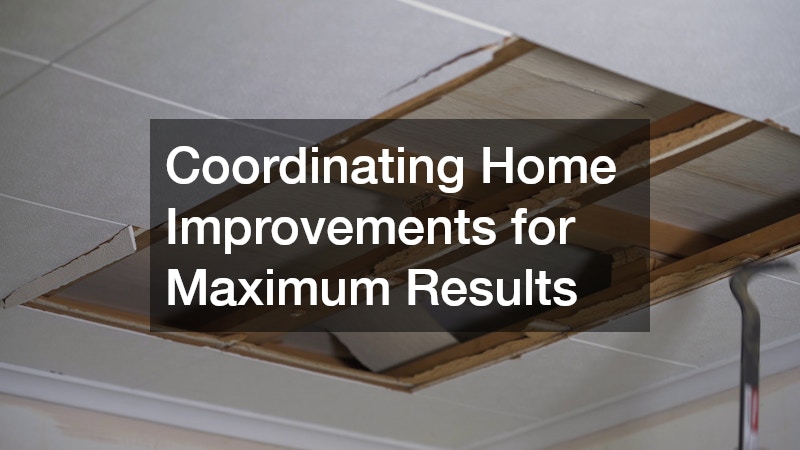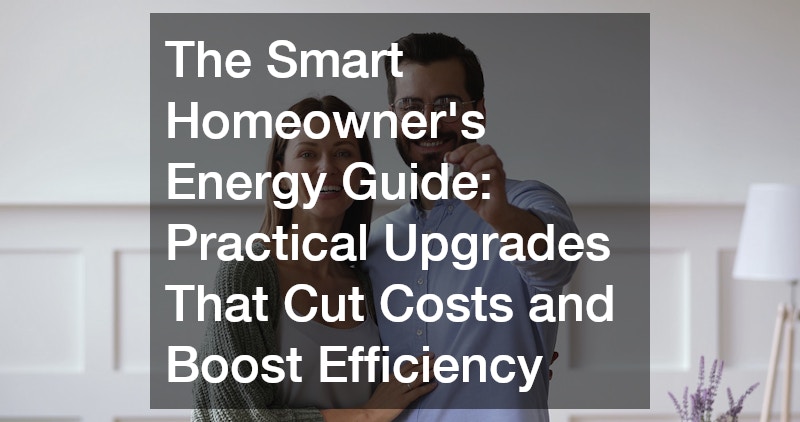Saving energy at home is not just about cutting utility bills; it is also about creating a more sustainable, comfortable, and efficient living environment. Homeowners today have access to a wide variety of tools, technologies, and services that can make a big difference in daily energy use. From improving insulation to upgrading lighting and power systems, there are practical steps anyone can take without having to commit to a full-scale renovation. This energy guide will walk you through some of the most effective ways to reduce waste, conserve resources, and enhance the value of your property. Each section explores a different area of home improvement, highlighting professional services and specific upgrades that play a role in overall efficiency. By following these tips, you can feel confident that every investment you make is working toward long-term energy savings, improved comfort, and a smaller carbon footprint.
Another reason this guide is so important is that energy costs continue to rise, and unpredictable weather events often increase the strain on household systems. By staying ahead of the curve, homeowners can protect themselves from sudden expenses while making their homes more resilient. Small changes, when combined with professional expertise, can lead to remarkable savings. Whether you’re preparing for seasonal changes, upgrading outdated systems, or looking to make your home more eco-friendly, these strategies provide the clarity you need to make smart decisions.
Maximizing Efficiency With Professional Electrical Work
One of the best places to start when considering energy efficiency is your home’s electrical system. Outdated wiring, overloaded panels, or inefficient appliances can all contribute to higher-than-necessary energy consumption. Working with qualified electricians ensures that your electrical infrastructure is up to modern standards, which directly supports energy-saving efforts. These professionals can assess your system, recommend upgrades, and even install advanced solutions like programmable thermostats or energy-efficient circuit setups. They can also verify whether your home is properly equipped to handle renewable energy sources, such as solar or wind systems, if you plan to add them later. In this section of the energy guide, the key takeaway is that professional input is invaluable. Attempting electrical work on your own may lead to safety risks or wasted investment. By partnering with experts, you gain peace of mind knowing that your system is optimized, safe, and ready to support efficiency improvements in the rest of your home.
Increasing Resilience With Backup Power Options

Power outages can happen at any time, leaving homeowners vulnerable to interruptions in heating, cooling, refrigeration, and general comfort. This is why reliable backup power solutions should be considered a vital part of your energy-saving strategy. Investing in generator services not only provides security during emergencies but also helps manage energy use more effectively throughout the year. Modern generators are designed to operate efficiently, automatically turning on when the grid fails, and some models are even compatible with renewable energy systems. A skilled professional can help size and install the right unit for your property, ensuring that essential systems run smoothly without wasting fuel. When thinking about the role of backup power in this guide, it is clear that preparation is not just about safety. It also plays a role in efficiency by reducing the stress and costs associated with unplanned outages, spoiled food, or compromised heating systems. The key is to integrate backup power in a way that complements the rest of your home’s energy strategy.
Reducing Consumption Through Smarter Lighting

Lighting often represents a surprisingly large portion of household energy use, but it is also one of the easiest areas to improve. Custom lighting services offer homeowners the ability to design solutions that are both functional and efficient. For example, swapping outdated incandescent fixtures for LED alternatives can reduce energy usage significantly. However, professional customization goes beyond simply replacing bulbs. It involves thoughtful design, such as zoning lights with dimmers, installing motion sensors, or integrating smart controls that adjust lighting automatically depending on the time of day or occupancy. These upgrades not only cut energy waste but also improve the comfort and style of your home. As you explore the lighting section of this energy guide, it becomes clear that smart design decisions amplify savings. By tailoring lighting to your unique needs, you reduce unnecessary usage while still creating a welcoming, attractive environment. This is a small step that brings outsized benefits in terms of both energy costs and everyday living quality.
Protecting Your Home Through Roof Improvements
Your roof plays a critical role in how much energy your home consumes, especially in regulating indoor temperatures. Poor insulation or structural damage can lead to significant heat loss in winter and heat gain in summer, forcing your heating and cooling systems to work harder. Professional roofers can identify weak points, replace damaged materials, and recommend energy-efficient upgrades like reflective coatings or advanced shingles designed to improve thermal performance. Roof improvements are an often-overlooked part of any energy-saving plan, but they make a big difference in long-term comfort and cost control. A roof that is well-maintained and properly designed reduces strain on HVAC systems, lowering utility bills year after year. Within the broader guide, roof care represents both a preventive and a proactive measure. By addressing potential inefficiencies at the top of your home, you ensure that every other energy-saving improvement you make will perform better, maximizing the return on your investments.
Enhancing Outdoor Spaces With Efficient Lighting

The exterior of your property can also contribute to energy waste if not managed properly. Many homeowners overlook outdoor lighting, assuming it plays only a minor role in total consumption. However, installing low voltage landscape lighting is a smart way to create curb appeal, improve safety, and keep energy usage in check. This type of lighting provides sufficient brightness without the high demand of traditional floodlights, making it an ideal upgrade for pathways, gardens, or security purposes. Additionally, when paired with timers or motion sensors, these systems ensure light is only used when needed. In this energy guide, outdoor lighting stands out as a simple yet impactful area to target. It allows homeowners to strike the right balance between functionality and efficiency while also enhancing the visual appeal of the property. By implementing efficient outdoor solutions, you ensure that your energy-saving efforts extend beyond the walls of your home and contribute to a consistent, holistic approach.
Harnessing Renewable Energy for Long-Term Savings
One of the most powerful upgrades a homeowner can consider is investing in renewable energy technology. Installing solar panels reduces reliance on fossil fuels and provides a clean, renewable source of power for your household. Advances in technology have made solar more accessible and cost-effective, with many systems capable of generating enough energy to cover most, if not all, of a home’s electricity needs. Beyond the financial savings, solar installations also increase property value and contribute to broader environmental goals. Professional installers ensure panels are positioned for maximum efficiency, taking into account factors like roof angle, shading, and local climate. In the context of this energy guide, solar represents the ultimate step in energy independence. By generating your own electricity, you not only protect yourself from fluctuating energy prices but also reduce your carbon footprint substantially. For homeowners seeking long-term solutions, solar energy is an investment that pays dividends for decades.
Coordinating Home Improvements for Maximum Results

Large-scale energy-saving projects often require more than one specialized service provider. That is where general contractors become invaluable partners. They oversee multiple aspects of a project, ensuring that every upgrade is completed efficiently and effectively. For example, a contractor might coordinate insulation work, HVAC improvements, and window replacements to create a cohesive strategy that maximizes energy savings. By managing timelines, budgets, and resources, they reduce the stress that homeowners might face when trying to handle multiple services independently. Within this guide, contractors serve as the link that ties everything together, making sure that upgrades do not work against one another but instead complement the overall efficiency plan. Partnering with experienced contractors ensures that your energy-saving projects are delivered on time, within budget, and with the highest level of quality, creating lasting results for your home.
Choosing Efficient Heating Solutions
Heating systems are among the largest contributors to household energy consumption, so finding efficient solutions is critical. Many homeowners still rely on traditional heating fuels, and the choice of energy source can impact both costs and sustainability. For example, home heating oils remain a popular option in many regions, offering reliable warmth during the winter months. Modern delivery services provide cleaner-burning options that are designed to reduce emissions and improve efficiency. Homeowners who choose this approach can pair oil systems with energy-efficient boilers or furnaces to get the most from their investment. In this energy guide, heating is framed not just as a necessity but as an opportunity to improve comfort while controlling costs. By working with suppliers who offer advanced heating products, you ensure that your system performs optimally, conserving fuel and minimizing waste. Heating efficiency is not just about saving money—it is about keeping your home comfortable without compromising sustainability goals.
Supporting Sustainability Through Recycling Programs
Energy efficiency is not only about the systems you install but also about how you manage waste. Partnering with grease recycling companies provides homeowners with a way to reduce environmental impact while supporting a circular economy. While most people associate grease recycling with restaurants or food service, many households also generate waste oils that should not be poured down the drain. Recycling companies collect these byproducts and convert them into biofuels or other usable materials, preventing harmful blockages in sewer systems and reducing dependence on traditional fuels. Including waste management in this energy guide highlights the fact that small, everyday decisions can also contribute to broader energy savings. By participating in recycling initiatives, you reduce strain on infrastructure, support renewable energy production, and demonstrate a commitment to responsible living. This shows that energy efficiency is not limited to what happens inside your home but extends to how you handle waste and resources.
Improving Comfort With Advanced Insulation
Finally, insulation is one of the most important factors in determining your home’s overall efficiency. Without proper insulation, even the most advanced heating and cooling systems will struggle to maintain comfortable temperatures without excessive energy use. Spray foam insulation contractors provide an effective solution, offering products that seal gaps, reduce air leakage, and create a consistent thermal barrier. Unlike traditional materials, spray foam expands to fill even small spaces, ensuring maximum coverage and performance. This results in reduced energy bills, improved indoor comfort, and greater durability over time. In this energy guide, insulation is positioned as a foundational investment, one that enhances the effectiveness of every other upgrade. By working with professional contractors, you can be confident that your home is equipped to handle seasonal extremes without wasting valuable resources. Good insulation transforms the efficiency of your property, protecting both your wallet and the environment.
Creating an energy-efficient home is not about one single upgrade but about taking a holistic approach that combines multiple strategies. It has also highlighted the importance of everyday decisions, such as participating in recycling programs or upgrading lighting. Together, these choices create a powerful framework for reducing costs, conserving resources, and enhancing comfort. By approaching energy savings step by step and working with qualified professionals, homeowners can achieve lasting improvements that benefit both their families and the environment. The key is to remain proactive, plan ahead, and use this energy guide as a roadmap for making informed decisions that pay off for years to come.
Finally, remember that efficiency is an ongoing process rather than a one-time project. Regular maintenance, periodic upgrades, and staying informed about new technologies ensure your home remains up to date and cost-effective. By keeping this energy guide handy and revisiting its strategies over time, you can continue to build on your progress. The result is not only a home that operates more efficiently but also one that provides comfort, security, and value for generations to come.



